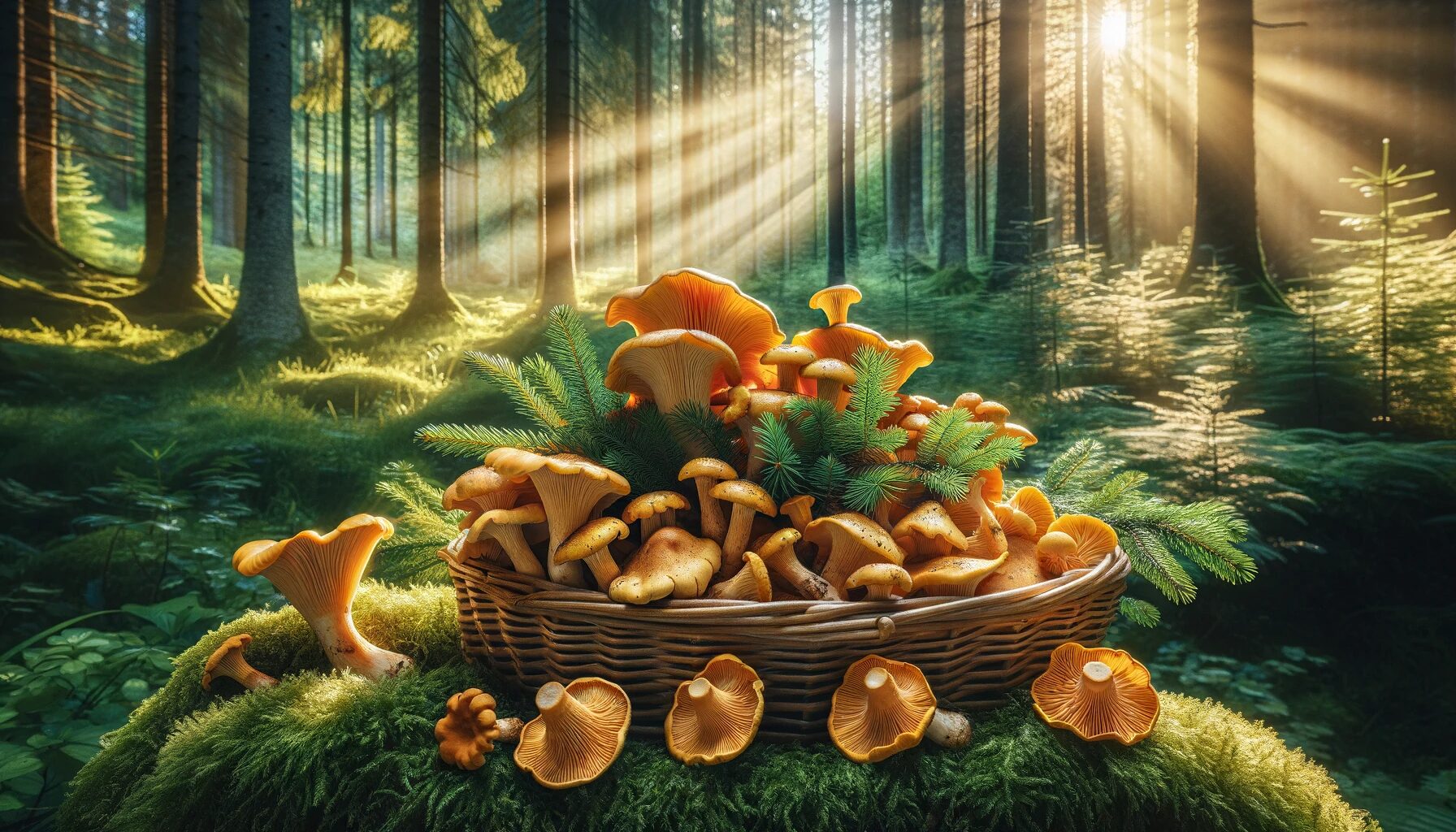Chanterelle mushrooms, known scientifically as Cantharellus cibarius, are a highly sought-after variety of wild mushrooms known for their distinctive shape, vibrant color, and unique flavor. These gourmet fungi are not only a delicacy in culinary circles but also possess various health benefits.
Nutritional Profile
Chanterelle mushrooms, a gourmet favorite in the culinary world, are not just prized for their unique flavor and texture, but also for their impressive nutritional profile. These fungi are a treasure trove of nutrients that contribute to various health benefits.
Vitamins and Minerals:
- Vitamin D: Uncommon in plant sources, chanterelles are a natural source of Vitamin D, crucial for bone health and immune function.
- B Vitamins: These mushrooms are particularly rich in B vitamins like niacin (B3), riboflavin (B2), pantothenic acid (B5), and folate (B9). Niacin helps in energy metabolism and maintaining healthy skin. Riboflavin is essential for cellular function and energy production. Pantothenic acid plays a role in synthesizing and metabolizing proteins, carbohydrates, and fats. Folate is key for DNA synthesis and repair.
- Minerals: They are a good source of essential minerals like potassium, which regulates fluid balance and nerve signals; copper, integral for energy production and iron absorption; selenium, a powerful antioxidant; and manganese, involved in bone formation and blood clotting.
- Dietary Fiber: Chanterelles are a good source of dietary fiber, promoting digestive health, aiding in cholesterol management, and helping in regulating blood sugar levels.
- Proteins and Amino Acids: They provide a decent amount of protein compared to other vegetables, including essential amino acids that the body cannot synthesize.
- Low in Fat and Calories: These mushrooms are low in both fat and calories, making them an ideal ingredient for weight-conscious diets.
- Antioxidants: Chanterelles contain antioxidants like lutein, zeaxanthin, and beta-glucans. Lutein and zeaxanthin are known for protecting eye health, while beta-glucans support immune function and may have a role in cancer prevention.
- Anti-Inflammatory Compounds: They contain natural anti-inflammatory compounds that can help in reducing inflammation in the body, beneficial for those suffering from inflammatory conditions.
- Water Content: High in water content, chanterelles help in hydration and maintaining a balance of fluids in the body.
- Trace Elements: These mushrooms also provide trace elements like zinc and iron, though in smaller amounts. Zinc is vital for immune function and wound healing, while iron is essential for transporting oxygen in the blood.
This rich and varied nutritional profile makes chanterelle mushrooms not just a delicious addition to meals but also a beneficial one from a health perspective. Incorporating chanterelles into your diet can contribute significantly to your overall nutrient intake, supporting various aspects of health from immune function to heart health.
Health Benefits of Chanterelle Mushrooms
The impressive nutritional profile of chanterelle mushrooms translates into a range of health benefits. Their unique composition of vitamins, minerals, antioxidants, and other bioactive compounds offer several advantages for overall health and well-being.
Boosts Immune System:
The high levels of Vitamin D and selenium in chanterelles contribute to a stronger immune system. Vitamin D is known for its role in immune regulation, while selenium is crucial for the proper functioning of the immune response.
Promotes Heart Health:
Potassium, found in significant amounts in chanterelles, helps in regulating blood pressure levels, thereby reducing the risk of hypertension and associated cardiovascular diseases.
The dietary fiber in these mushrooms can aid in lowering bad cholesterol (LDL) levels, further promoting heart health.
Enhances Vision:
Antioxidants like lutein and zeaxanthin in chanterelles are known for their role in eye health, particularly in preventing macular degeneration and cataracts.
Supports Bone Health:
The presence of Vitamin D in chanterelles aids in calcium absorption and bone mineralization, making them beneficial for bone health and in the prevention of osteoporosis.
Aids in Digestive Health:
The dietary fiber in chanterelles helps in promoting regular bowel movements, preventing constipation, and maintaining a healthy gut flora.
Mood Regulation and Mental Health:
Vitamin D has been linked to mood regulation and may help in reducing the symptoms of depression and anxiety. The B vitamins in chanterelles also play a role in brain health and functioning.
Anti-Inflammatory Effects:
Chanterelles contain compounds with anti-inflammatory properties, which can be beneficial in reducing inflammation and may help in managing conditions like arthritis and other inflammatory diseases.
Cancer Prevention Potential:
The antioxidants and beta-glucans in chanterelles may have a role in cancer prevention. Beta-glucans are known for their immune-boosting properties, which could potentially help in protecting against cancer.
Weight Management:
Being low in calories and high in fiber, chanterelles can be a satisfying addition to a weight loss diet, helping in weight management without compromising on nutrition.
Skin Health:
The array of B vitamins, along with selenium and antioxidants, contribute to healthy skin by combating oxidative stress and aiding in cell regeneration.
Supports Muscle Function:
The potassium and other minerals in chanterelles help in muscle health, preventing cramps, and maintaining proper muscle function.
These health benefits make chanterelle mushrooms not only a culinary delight but also a functional food with significant contributions to various aspects of health. Including these mushrooms in your diet could be a delicious way to enhance your nutritional intake and support overall health.
Foraging and Identification
Foraging for chanterelle mushrooms can be a rewarding experience, but it requires knowledge and caution to accurately identify them and avoid toxic look-alikes. Here’s a detailed guide on how to forage and identify these prized mushrooms.
Habitat:
- Chanterelles typically grow in hardwood forests, especially under oak, beech, birch, and conifer trees.
- They favor moist, well-drained soils rich in organic matter and often appear after a rain in late summer and fall.
- They can be found in both mountainous and lowland areas, often forming symbiotic relationships with the roots of trees.
Appearance:
- Cap: Chanterelle mushrooms have distinctive, funnel-shaped caps with wavy, irregular edges. The cap color ranges from yellow to deep orange or gold.
- Gills: Unlike many mushrooms, chanterelles have ridges or false gills that appear as forked and cross-veined, running down the stem. These ridges are more blunt and less defined than true gills and are the same color or slightly lighter than the cap.
- Stem: The stem is solid, thick, and the same color or slightly lighter than the cap. It tapers down towards the base and is usually central and straight.
- Size: They can vary in size but typically have caps that range from 2 to 10 centimeters in diameter.
Timing and Climate:
Chanterelles typically fruit from early summer to late fall, depending on the local climate and weather conditions. They thrive in a climate with good moisture and moderate temperatures.
Scent and Taste:
These mushrooms have a distinctive fruity smell, often described as apricot-like. Their taste is mild, slightly peppery, and nutty, making them unmistakable in flavor.
Caution and Look-Alikes:
- The most common look-alike is the false chanterelle (Hygrophoropsis aurantiaca), which is more orange, with true, forked gills, and lacks the apricot scent.
- The Jack O’Lantern mushroom (Omphalotus olearius) is also similar in appearance but is toxic. It grows in clusters on wood, not on the ground, and its gills glow in the dark.
- Always forage with an experienced guide or use a reliable field guide to ensure correct identification.
Sustainable Foraging:
- When foraging, cut the mushrooms at the stem base to avoid disturbing the mycelium.
- Avoid overharvesting in one area to ensure that the mushrooms can continue to grow in subsequent seasons.
By following these guidelines, foragers can safely and sustainably enjoy the hunt for chanterelle mushrooms. It’s important to always err on the side of caution and never consume a mushroom unless you are 100% certain of its identification.
Culinary Uses of Chanterelle Mushrooms
Chanterelle mushrooms are highly regarded in the culinary world for their unique flavor and texture. They offer a range of possibilities in the kitchen, from simple sautéing to incorporation into complex dishes. Below are expanded details on their culinary uses.
Preparation Basics:
Before cooking, chanterelles should be gently cleaned with a soft brush or damp cloth to remove debris. Avoid soaking them in water as they can absorb moisture and become soggy. These mushrooms can be eaten whole if small, or sliced or chopped if larger.
Cooking Techniques:
- Sautéing: Chanterelles have a delicate flavor that is enhanced when sautéed in butter or olive oil. They release their moisture quickly, so it’s advisable to cook them on medium-high heat to get a nice sear.
- Grilling: Their firm texture makes them suitable for grilling. Brushing them with oil and seasoning before grilling can enhance their flavor.
- Roasting: Roasting chanterelles in the oven concentrates their flavor and adds a slightly crispy texture.
Flavor Pairings:
Chanterelles have a slightly peppery, nutty flavor with a hint of fruitiness. They pair well with creamy sauces, garlic, onions, thyme, parsley, and white wine. They complement the flavors of eggs, chicken, pork, and veal.
Dishes:
- Risottos and Pastas: Their texture and flavor work well in creamy risottos and pasta dishes.
- Soups and Stews: Chanterelles can be added to soups and stews, lending a depth of flavor.
- Omelets and Quiches: Their delicate texture and flavor make them ideal for inclusion in omelets and quiches.
- Stuffings and Sauces: They can be used in stuffings for meats or as a base for flavorful sauces.
Preservation:
If you have an abundance of chanterelles, they can be dried for long-term storage. Dried chanterelles can be rehydrated and used in cooking, offering a more concentrated flavor.
They can also be pickled or frozen, although freezing may alter their texture slightly.
Culinary Tips:
To fully appreciate their flavor, it’s best not to overpower chanterelles with too many strong spices or herbs.
They should be added towards the end of the cooking process in dishes like stews or soups to preserve their texture and flavor.
Nutritional Cooking:
For those looking to leverage the nutritional benefits of chanterelles in cooking, it’s advisable to pair them with other nutrient-dense foods like leafy greens, whole grains, and lean proteins.
Chanterelle mushrooms’ versatility in the kitchen makes them a favorite among chefs and home cooks alike. Whether it’s a simple sauté or a component in a sophisticated dish, chanterelles bring a distinctive flavor and texture that enhances a wide variety of recipes.
Recipe: Chanterelle Mushroom Risotto
Ingredients:
- Fresh chanterelle mushrooms, 1 cup
- Arborio rice, 1 cup
- Vegetable broth, 4 cups
- White wine, 1/2 cup
- Onion, finely chopped, 1
- Garlic cloves, minced, 2
- Grated Parmesan cheese, 1/2 cup
- Fresh parsley, chopped, 2 tbsp
- Olive oil
- Salt and pepper to taste
Instructions:
- Prepare the Mushrooms: Clean the chanterelles gently with a brush and chop them into bite-sized pieces.
- Sauté: In a large skillet, heat olive oil over medium heat. Add onions and garlic, sautéing until translucent. Add the chanterelles and cook until they release their moisture.
- Cook the Risotto: In another pot, heat a little olive oil and add the Arborio rice. Stir for a minute. Add white wine and stir until absorbed. Gradually add the vegetable broth, one cup at a time, stirring continuously until the liquid is absorbed before adding more.
- Combine: Once the rice is al dente, add the sautéed mushrooms, Parmesan cheese, parsley, salt, and pepper. Stir well.
- Serve: Serve hot, garnished with additional parsley and cheese if desired.
Conclusion
Chanterelle mushrooms are not just a culinary treat but also a nutritional powerhouse. Their unique flavor and health benefits make them an excellent addition to a variety of dishes. By incorporating chanterelles into your diet, you can enjoy their delicious taste while reaping their health advantages.
FAQs
Q1: Can I find chanterelle mushrooms in grocery stores?
- A1: Chanterelle mushrooms are typically found in gourmet or specialty stores rather than regular grocery stores. However, their availability can vary based on location and season.
Q2: How do I store chanterelle mushrooms?
- A2: Store chanterelles in a paper bag in the refrigerator. Avoid plastic bags as they trap moisture. Fresh chanterelles typically last up to a week when stored properly.
Q3: Are chanterelle mushrooms safe to eat raw?
- A3: It’s not recommended to eat chanterelles raw due to potential bacteria and their tough texture. Cooking them not only makes them safer to eat but also enhances their flavor.
Q4: How can I tell if a chanterelle mushroom has gone bad?
- A4: Spoiled chanterelles may have a slimy texture, dark spots, or an off-odor. Discard any mushrooms that show these signs.
Q5: Can I freeze chanterelle mushrooms?
- A5: Yes, you can freeze chanterelles. For best results, cook them slightly before freezing. This preserves their texture and flavor better than freezing them raw.
Q6: How do I rehydrate dried chanterelle mushrooms?
- A6: Soak dried chanterelles in warm water for about 20-30 minutes. Save the soaking liquid for added flavor in soups and sauces.
Q7: Are chanterelle mushrooms good for weight loss?
- A7: Yes, chanterelles are low in calories and high in fiber, making them a good addition to a weight loss diet. However, they should be part of a balanced diet.
Q8: Can I pick chanterelle mushrooms in the wild?
- A8: Yes, but you should be very knowledgeable about mushroom identification or go with an experienced forager. Misidentification can lead to consuming toxic mushrooms.
Q9: What’s the best way to cook chanterelle mushrooms?
- A9: Sautéing is one of the best ways to cook chanterelles as it enhances their flavor and maintains their texture. They can also be grilled, roasted, or added to soups and stews.
Q10: Do chanterelle mushrooms have medicinal properties?
- A10: While chanterelles are rich in nutrients and antioxidants, they are not classified as medicinal mushrooms like some other varieties. However, they do contribute to overall health and wellness.

Alex is a seasoned writer and researcher, specializing in psychedelic studies and mental health. Known for insightful and authoritative content, he combines extensive knowledge with a passion for exploring wellness and alternative therapies. Alex’s work is a trusted resource for readers delving into the world of mental well-being.


Leave a Reply